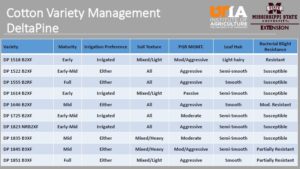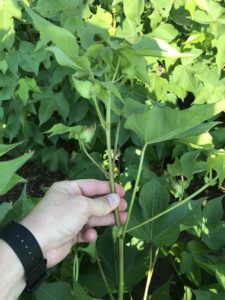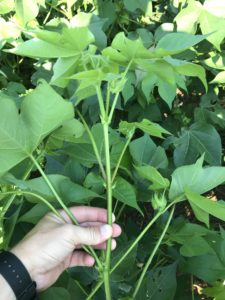 At the moment, cotton appears to be growing almost as fast as palmer amaranth; rains and abnormally warm temperatures have promoted rapid growth and the second (or third) application of Plant Growth Regulators (PGRs) are currently being applied. With our current growing conditions, forecast, and planted cultivars, I’m applying and recommending aggressive rates; now that the root zone has expanded and N uptake has begun to increase exponentially, expect rapid plant growth to continue in areas which have adequate moisture. This blog highlights points to be considered when attempting to regulate growth in 2018.
At the moment, cotton appears to be growing almost as fast as palmer amaranth; rains and abnormally warm temperatures have promoted rapid growth and the second (or third) application of Plant Growth Regulators (PGRs) are currently being applied. With our current growing conditions, forecast, and planted cultivars, I’m applying and recommending aggressive rates; now that the root zone has expanded and N uptake has begun to increase exponentially, expect rapid plant growth to continue in areas which have adequate moisture. This blog highlights points to be considered when attempting to regulate growth in 2018.
Variety Responsiveness to PGRs
New varieties have again taken large chunks of our 2018 acreage. Limited information on response to PGR applications is available for several new varieties, so I would encourage you to again base PGR timing and rate off of plant measurements (see section gauging current growth). The pdf linked here and below represents our best guess as to how varieties will respond. Classification is based on determinacy (more determinate varieties are typically more responsive and indeterminate varieties are commonly less responsive), growth habit (more vigorous varieties will require more and are therefore considered less responsive) and direct response to the regulator (variety sensitivity is largely influenced by the aforementioned factors, but specific response can vary independently based on plant response to the regulator).
The best approach to managing growth in a new variety is to base applications on plant growth measurements. Several different measurements can be used but the emphasis should be placed on current growth. One of the best ways to gauge current growth is to measure the internode length between the fourth and fifth nodes.
If the distance between fourth and fifth node is:
- Less than 2”: Growth inadequate. Application is not warranted.
- Between 2” to 3”: Growth is adequate; a low application may be warranted on ‘strong’ ground, but applications in this range are not universally warranted.
- Exceeds 3”: Growth is excessive. The potential for rank growth is high and a strong application should be considered.
The most common application strategy for a 4.2% mepiquat chloride product is to apply (AS NEEDED):
- 4-8 oz one to two weeks prior to bloom,
- 8-16 oz two to three weeks after first application (during first or second week of bloom) *I’m really pushing this rate up now
- 16-24 oz one to two weeks after second application (prior to cutout).
Rates and timing mentioned above should be adjusted based on observed conditions; if excessive growth is present or expected, the variety is considered to be less responsive to PGRs, and/or the field has a history of rank growth, selected rates should represent the top-end of the rate range listed above. If only adequate growth is observed, the variety is considered to be very responsive to PGRs, and/or the field does not have a history of rank growth, selected rates should represent the low-end of the range listed above. If the plant is stressed in any way or growth is considered to be inadequate, a PGR should not be applied.
In both images pictured below, an application is clearly warranted. However, the plant pictured right with a very large internode should receive more than the plant pictured left. I share these images to emphasize applications should be adjusted on observed conditions.


PGR Use and Target Spot
For those who struggled with Target Spot last year, I would encourage you to consider an aggressive plant growth management strategy. Observations from the 2015, 2016 and 2017 seasons have suggested canopy humidity may be one of the driving factors for the disease. Cotton Specialists and several Pathologists within the MidSouth are investigating these relationships through field research during the 2018 season. Still, I believe there is enough circumstantial evidence present to suggest properly applying nitrogen, planting to achieve populations of 35,000-45,000 plants per acre, and aggressively managing plant growth can reduce humidity levels within the canopy and therefore MAY eliminate the need for a foliar fungicide application to manage Target Spot in the Upper MidSouth.
Additional thoughts:
The main goal is to use PGRs to govern vegetative growth until the reproductive sinks begin to naturally govern vegetative growth. Given fruit retention is adequate, the transition to reproductively governed vegetative growth should occur during the effective flowering period.
PGRs do not shrink the plant; instead, they ultimately reduce internode elongation (among other things). Although yield increases due to PGR applications are not consistent, PGRs consistently increase the penetration of insecticides into the canopy and increase harvest efficiency.
If applied during a stress (particularly drought stress) or immediately prior to the onset of stress, yields can be negatively affected.
Do not use more than a total of 48 fl. oz. of 4.2% mepiquat chloride per acre in a growing season- that is the maximum allowed by the label.
Several PGRs are currently available, but results of a regional Beltwide study noted no significant differences in effectiveness of formulations of mepiquat chloride, mepiquat chloride + kinetin, mepiquat chloride + cyclanilide, and mepiquat pentaborate when used at equivalent rates (Dodds et al., 2010). Additionally, new mepiquat chloride products are currently available at much higher concentrations than the original 4.2% formulation. We typically refer to rates of the 4.2% products. If you select a product other than a 4.2% mepiquat chloride formulation, make sure you adjust rate. Rainfastness does vary from product to product.

